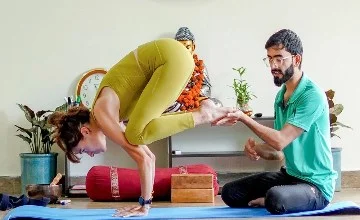hanmukhi mudra is a simple and easy practice that not only brightens and rejuvenates the face and the eyes but also brings a state of balance. This ancient technique helps to increase awareness and meditativeness of our mind and makes it a valuable addition to your wellness routine. Embrace the power of shanmukhi mudra to enhance your overall well-being and achieve inner harmony.
Table of Contents
ToggleWhat Is Shanmukhi Mudra: Meaning And Significance
The term shanmukhi mudra is derived from three Sanskrit roots: “Shan” meaning six, “Mukhi” meaning face or gate and “Mudra” meaning gesture or seal. It is a powerful mudra that involves closing the six gates or senses and focuses on the practice of pratyahara, also known as withdrawal of senses. These six gates represent the six senses which are eyes, nose, ears, mouth, skin, and mind.
qBy closing these gates you can shift your focus inward and detach yourself from the external distraction. As one of the famous yogi said, if you turn inward, you will find a space where there is a solution for everything. Practicing shanmukhi mudra prepares the yogi to master the practice of pratyahara or sensory withdrawal.
Steps To Do Shanmukhi Mudra: (A Step-By-Step Guide)
Here are the easy step-by-step instructions to do Shanmukhi Mudra.
- Sit straight and relaxed.
- Place your index fingers over your eyes, middle finger at the side of the nostrils, ring fingers above your lips, and little fingers below your lips, and close the ear with your thumbs.
- Rest your middle fingers softly on the nostrils without closing them and breathe deeply, take your awareness inward with each breath and detach yourself from external distractions.
- After taking a couple of deep breaths inhale deeply and with exhalation make a bee sound as long as you can make it.
- You can start with 5-10 breaths and gradually increase the practice to 8-10 minutes.
By following these simple steps to do shanmukhi mudra, you can improve your meditation practice and achieve greater inner awareness.
Benefits of Shanmukhi Mudra:
- Shanmukhi mudra effectively calms the mind and soothes the nervous system, promoting overall mental tranquility.
- Relaxes and rejuvenates the eyes and facial muscles, providing relief from strain and fatigue by soothing the facial nerves.
- Shanmukhi mudra is beneficial for relieving vertigo, tinnitus, and moving sickness helping to reduce discomfort through nervous relaxation.
- Shanmukhi mudra is beneficial for managing anxiety and eliminating negative mental patterns and promoting a positive mindset.
- Shanmukhi mudra improves spiritual growth when practiced regularly under the guidance of a yoga teacher, as it helps to withdraw senses, creating a state of Pratyahara, essential for deeper meditation and clear thinking.
- Shanmukhi mudra sets the path for nada yoga, the practice of connecting to inner sounds, exploring the deeper world within.
Contraindication of Shanmukhi Mudra:
- Always practice shanmukhi mudra under the guidance of a qualified yoga teacher until you master it and feel comfortable.
- People with glaucoma should avoid or be gentle while practicing shanmukhi mudra due to the pressure over the eyes.
- Apply gentle pressure to the eyes and ears. Pressing too hard without understanding the sensations can cause pain in the ear and irritation.
- If you have a depression history then start with 2-3 minutes of practice and gradually increase the duration if you feel comfortable.
- People with a history of heart issues, high blood pressure, migraine, asthma should avoid breath retention.
Common Asked Questions
A: Shanmukhi mudra helps to rejuvenate eyes, face, reduce stress and improve concentration.
A: You can start practicing shanmukhi mudra with 5 minutes in the beginning then gradually increase your practice to 10-15 minutes and you can do this 4-5 times a week.
A: The best time to practice shanmukhi mudra is early morning and evening as early morning practice helps to set the peaceful tone for the day and evening practice is good for restful sleep.











